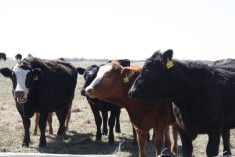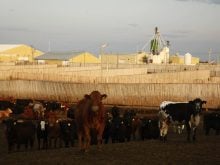This cattle market information is selected from the weekly report from Canfax, a division of the Canadian Cattlemen’s Association. More market information, analysis and statistics are available by becoming a Canfax subscriber by calling 403-275-5110 or at www.canfax.ca.
Fed cattle rise
The fed steer weighted average was $134.92 per hundredweight, up $2.52, and heifers averaged $133.94, up $2.53.
The steer cash price was the highest since the second half of August.
Support came from the stronger U.S. cash market, the bullish U.S. cattle-on-feed report and the rising Chicago live cattle futures market. The on-feed report showed September placements were well below expectations.
Read Also

Flax sector sees omega-3 opportunity
SASKATOON — A global shortage of omega-3 oils could be an opportunity for the flax sector, says an industry official….
In Canada, buyers turned to the cash market as fewer grid cattle were marketed.
Slaughter volumes were down six percent from last year. It was only the second time in the past 28 weeks that Canadian beef production (fed cattle) was below year-ago levels.
Cattle-on-feed data for February to April shows that light stocker placements weighing less than 700 pounds were up 50 percent, or 35,000 head, compared to the previous year.
Many of these spring-placed stockers have been on feed for more than 200 days and likely going to market now.
Canadian fed cattle exports are running well above year-ago levels. With historically strong basis levels, these exports are likely contract cattle.
Market-ready supply in Canada should tighten, and it might force packers to scale back hours.
U.S. cash prices were significantly stronger.
Dressed sales in the northern United States were US$6-$10 higher, while live sales in northern and southern feeding states sold at $105 per cwt.
Steer and heifer carcass weights increased three to four pounds but were below year ago levels.
Cows fall
A large volume led to lower prices, and ample supply will likely also weigh down the market this week
D1, D2 cows ranged C$78-$92 to average $85.25 per cwt., down $1.85.
D3s ranged $70-$82 to average $75.88.
Dressed cow bids were sharply lower at $160-$165 delivered.
Butcher bulls fell $4 to average $103.25.
Weekly western Canadian non-fed slaughter to Oct. 22 rose 10 percent to 5,560 head.
Weekly exports to Oct. 15 fell 10 percent to 4,698 head.
Fall calf run
Good pasture conditions and the delayed harvest pushed back the fall calf run, but the weekly auction volume last week surged 15 percent to 84,613 head. That was about the same as last year. This is usually the largest auction period of the year.
Alberta feeder cattle rose $4.50 per cwt. on a large offering.
Calves lighter than 500 lb. saw stronger prices, and middle weight feeders 500-800 lb. jumped $2.50-$4 higher.
Late grass yearlings continue to trickle to market, and interest intensified to place them against the strong April Chicago futures.
Steers heavier than 800 lb. rallied more than $6.50.
Similar weight heifers rose sharply by $10-$11.
Yearling heifers 850 lb. saw a $1.75 premium over 550 lb. heifer calves.
Weekly exports to Oct. 15 rose to 1,832 head.
Feedlot pen conditions in some areas have deteriorated to discourage placements, but pressure is mounting to fill pens.
Feeder prices should be steady this week.
US beef rises
Choice cutout rose US$3.65 to $181.54 per cwt., and Select climbed $1.07 to $168.81.Some seasonal supports are starting to develop as we get closer to the holidays.
Canadian prices were not available.














